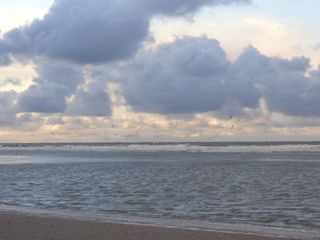Everybody else scrambles to the escalator down to the departures hall, but I go against the flow. I know that there’s an elevator and nobody else is following me. The elevator is up, and as I press the button, the doors open right away. I enter dragging my suitcase behind me. I turn and see only backs. I press the button for down and the doors close. Few seconds later they open again and I can join the flow of people from the escalator.
The departures hall is massive and the crowd quickly disperses. The ceiling is at least thirty meters high, there are massive advertisement sheets hanging from it. They tell you about cheap flight options and big building companies, there’s even an ad from the local power company hanging far to the right. The hall is massively wide too, it seems to go on and on in both directions. Fifty meters in front of me on the opposite side of the building, there are the check-in desks. Each desk is numbered and the one just opposite me has the number 115. There are rows of TV monitors close to where I’m standing and to the right and left of me. I can see more people entering the hall from the doors next to me. There are all the time taxis parking outside, leaving a passenger out and continuing. Next to the glass elevators there’s a rectangular opening with railings around it. Through the three times three meter opening I can see downstairs. There’s the arrivals hall. Bored taxi drivers stand near the meeting point with signs on their hands, looking hopefully at each passerby. “Maybe this is Mr. Ching from Hong Kong. The flight landed twenty minutes ago. Where is he?” “What’s holding up Mrs. Semathier? I wish I had her number.” Some drivers even talk to the passersby like they were trying to convince them of being Mr. Ching or Mrs. Semathier. After a long flight, it is understandable if a foreigner doesn’t know how to read the sign. Maybe they’ve even forgotten their name because of the exhausting flight. Saying the name out loud, no matter how mispronounced it may be, just could wake them up and make a dead-tired traveller remember they are actually Mr. Ching from Hong Kong and not Bruce Tiller from Australia. But why is that driver talking to the male passengers and asking for Mrs. Semathier? Does he really believe that they’ve had enough time on the flight to perform a sex-change operation and recover enough from it to walk through the arrivals hall unaided. The anesthesia would explain forgetting one’s name, but how would the driver explain the men’s clothes former Mrs. Semathier is apparently wearing? Amused, I get back on track.
I’ve been here before and I know how it goes. I’ll first check the monitors for the check-in desk number allocated for my flight, then I’ll queue to the check-in desk and get rid of this suitcase. Then with my ticket I can go through security check and head for the gate to wait for the plane. There are eight TV monitors organized in a two-by-four arrangement. They list all the departing flights sorted according to their times of departure. Each flight is described with the destination city, the flight number, the departure time according to the timetable and the numbers of the assigned check-in desks. There’s also room for a comment about possible changes like delays or cancellations.
New York US345 11:35 115-125
Reykjavik SK176 11:35 214-220
Frankfurt TD876 11:40 183-185
Malaga FG034 11:40 91
Milan LK999 11:45 12-19 delayed until 12:10
Mental-mass IS879 11:50 555 wrong
Stockholm LH675 11:50 34-54
Hong Kong KA018 11:55 106-112
My flight is supposed to leave at 12:15. What did I see? There are two planes leaving at 11:50, one to Stockholm and another to ... Mexico City. Was that there before? Didn’t it say something else? No, apparently not. Aah, there it is, that’s my flight number, departure time is correct, 12:15, there’s no mention of a delay and the check-in desk is any desk between 67 and 75. To the right then. That’s the descending direction of check-in desks.
There are two people in the queue I choose. The other queues aren’t any longer, my flight destination doesn’t seem too popular. If the lines had been longer I would have used the automatic check-in machines, they are really handy, but now there’s no need. Two minutes later, it’s my turn.
“Hello, here’s my passport and my ticket.”
“Thank you, sir.” says the dark-haired check-in lady. She’s wearing the dark blue uniform suit like her colleagues on the neighboring desks.
“Would you like a window seat or aisle, sir?” she asks.
“Window, please”
She taps the keys on her computer terminal.
“Do you have just one piece of luggage?”
“Yes, just one.” I tell her and put my suitcase on the band. 20,2 kg say the scales. I know the limit is 20 kg but I also know that she won’t complain about such a small difference. Sometimes two kilos is no problem.
“Do you know that your mental-mass theory is absolutely wrong, sir?” she says suddenly and looks at me awaiting answer.
“Sorry?” I say, amazed! How could she know? I’ve just thought about that whole concept in the train. Nobody can know. She CAN’T know.
“Do you know that the meal on this flight is absolutely delicious, sir?” she repeats, probably notices the horror on my face and continues, “Nothing to be alarmed about. The meals are always delicious, but this week we have a special offer as our airline is testing new cuisine alternatives. Everybody, even in economy, will get the food meant for business class. This way we get a wider amount of opinions and can later serve business class passengers even better. You can consider yourself lucky, sir.”
“Oh, yeah, thank you.” I manage to mutter as I grab my passport and my boarding pass.
“Your flight leaves at 12:15 from gate 75. Have a pleasant flight!” she says and points to my left indicating the shortest way to the gate.
I’m a little shaken as I leave the counter. Am I hearing things? Is all this a little too much for my brain? Is this piece too big for me to chew? First the monitor and now the check-in lady. It must be my subconscious telling me something. What was the message? “Mental-mass is wrong.” What if that is true? Should I start over? I need a place to think and this departure hall is not the place. There’s too much noise, too many people, too many distractions. It will be much quieter at the gate.
Labels: Science of Software







